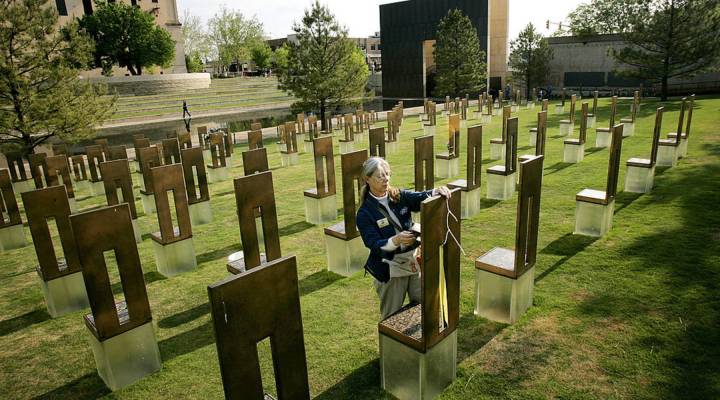
Why it’s difficult to "always remember"

Oklahoma City. April 19, 1995. A truck bomb exploded outside the Alfred P. Murrah Federal Building in Oklahoma City, killing 168 people. Hundreds more were injured.
In the years that followed, the community, with the help of the state and federal government and private donors, built the Oklahoma City National Memorial & Museum.
On the anniversary of the bombing in 2015, former President Bill Clinton gave a speech on the grounds.
“For 20 years you have honored the memories of your loved ones, you have inspired us with the power of renewal,” he said.
But, the work of remembering and renewing and honoring can be expensive.
“We spend about a million dollars a year on the outdoor memorial, keeping it up to date,” said Kari Watkins, the executive director of the Oklahoma City National Memorial & Museum.

The West Gate at the Oklahoma City National Memorial & Museum.
The foundation spent $10 million a few years back to update the museum, adding technology and artifacts to the exhibits. Watkins said it raises a significant portion of its revenue through ticket sales and a marathon each year. The organization also makes money from gift store sales, an endowment and traditional fundraising.
“While we want to maintain the sanctity and the beauty of the story, there is a business side to it,” Watkins said. This trick is balancing the two in a way that doesn’t offend.
The Oklahoma City memorial is on a large scale; most memorials to mass violence don’t have former U.S. presidents willing to come speak on anniversaries. Most are meant for their communities. And for all the promises to “always remember,” memorials can be hard to maintain.
“I think a lot of people think that memorials are permanent and forever,” said Erika Doss, a professor of American studies at Notre Dame and author of the book “Memorial Mania: Public Feeling in America.”
Many memorials being built today include plans for preservation and maintenance for five, 10, sometimes 20 years. But longer than that, said Doss, “the life of a memorial is also very much about those who want to take care of it, lay claim to it, want to respond to it.”
Which brings us to the Edmond Post Office memorial, about a 30 minute drive from Oklahoma City.
August 20, 1986. A postal worker in Edmond, Oklahoma, killed 14 of his co-workers. It was, at the time, the third-worst mass murder by a single shooter in U.S. history.
With the help of public donations, the community and U.S. Postal Service built a fountain and sculpture. It reportedly cost around $100,000 and was unveiled in 1989.

Edmond Post Office Memorial.
All these years later, Herb Rettke still tries to visit once a week.
“I go by to see how it is and remember all the guys and girls.”
Rettke worked at the post office in 1986. He wasn’t there at the time of the shooting. His shift hadn’t started, he said, but his friends, co-workers and brother-in-law were killed.
He said he’s one of the few people who still pushes to keep the memory of that day in people’s minds.

Herb Rettke.
The fountain stopped working for a while and it dried up. But the pipes were repaired in time for the 30th anniversary last year.
Rettke and a friend organized a ceremony. He plans to keep acknowledging that day, he said, “as long as the good Lord lets me on earth.”
For this year’s anniversary, the 31st, there was no planned public memorial. But Rettke placed 14 flags and a wreath with a yellow ribbon and the words “Never Forgotten.”
There’s a lot happening in the world. Through it all, Marketplace is here for you.
You rely on Marketplace to break down the world’s events and tell you how it affects you in a fact-based, approachable way. We rely on your financial support to keep making that possible.
Your donation today powers the independent journalism that you rely on. For just $5/month, you can help sustain Marketplace so we can keep reporting on the things that matter to you.












